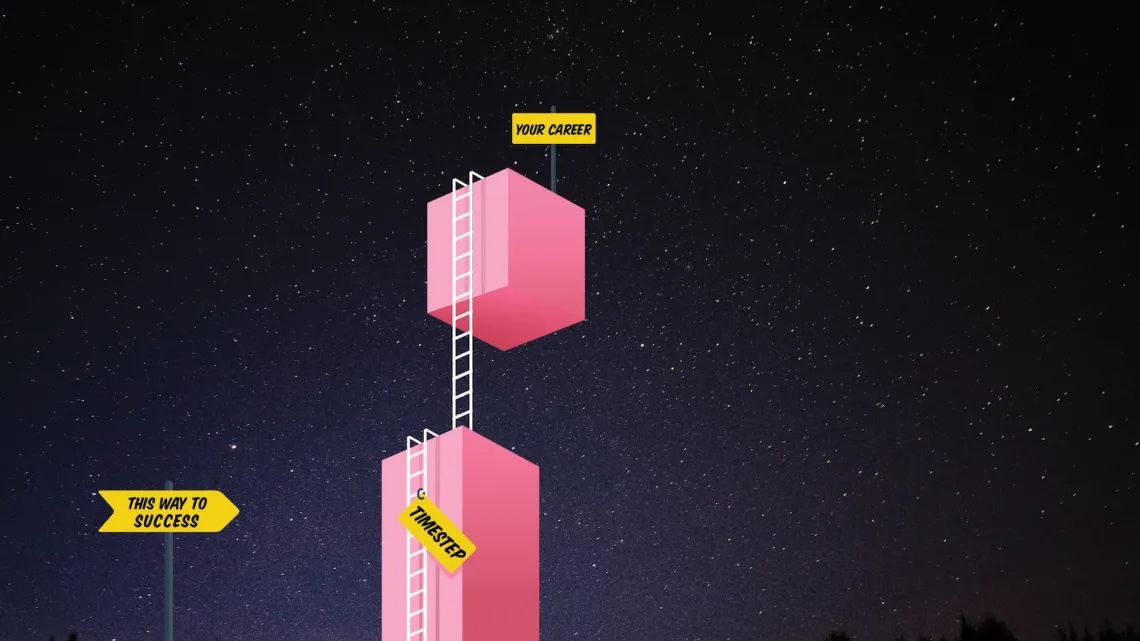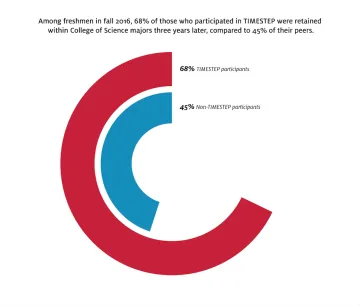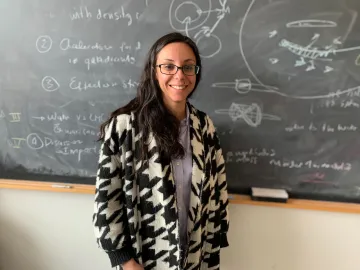On Student Success, This Astronomer Walks the Walk
Gurtina Besla, a UArizona assistant professor of astronomy, wants today’s students to have what she didn’t: community, paid internships, and clear paths to fulfilling careers—for which they’re actually prepared.

(Graphic by Colleen Loomis/RII)
In Gurtina Besla’s universe, astronomy would be access to all. She says the words with conviction, but also like she’s uttered them a thousand times before—and she probably has.
Besla, an assistant professor of astronomy at the University of Arizona, has received a five-year, $745,000 CAREER grant from the National Science Foundation for both her novel research on galaxies and dark matter and her outreach efforts to retain, mentor and support students in STEM studies.
The CAREER grant is the agency's most prestigious honor in support of early-career faculty members who have the potential to serve as academic role models and lead advances in the organization’s mission.
“In both her research and outreach, Besla is truly forward-thinking. I am pleased that the National Science Foundation has provided her with this richly deserved recognition,” said Senior Vice President for Research and Innovation Elizabeth “Betsy” Cantwell.
In addition to helping further her galactic research, the CAREER award will help Besla continue to build a program she founded in 2015 called TIMESTEP: the Tucson Initiative for Minority Engagement in Science and Technology Program.
“We want to help students graduate and get to the career paths they want and are excited about,” Besla said. “We want to level the playing field so that everyone has the same information and access to opportunity.”
TIMESTEP in Action
TIMESTEP is a professional development program for undergraduates, designed to provide them the information they need to succeed. Its 100 or so students majoring in astronomy, physics, mathematics, optical sciences, engineering and computer science meet twice a month over pizza or, occasionally, tamales.

(Graphic by Eddie Canto/RII)
To provide inspiration and access to mentorship, Besla invites faculty from across the country to come talk to the students about their cultural heritage and how they stay true to their identity in their chosen profession. Keith Hawkins, an astronomer who heads the Galactic Archeology Laboratory at the University of Texas at Austin, was a recent speaker. The meeting was held at UArizona’s African American Cultural Resource Center. Theoretical astrophysicists Jorge Moreno of Pomona College and Enrico Ramirez-Ruiz of UC Santa Cruz recently spoke to TIMESTEP students in the Adalberto & Ana Guerrero Student Center.
“Of course, anyone is welcome to come to TIMESTEP, but we typically invite speakers of color and design programs for minority students. Studies show that they need it more,” Besla said.
UArizona faculty members in Astronomy and Physics develop and lead TIMESTEP training programs, such as TIMESTEP cofounder Eduardo Rozo, associate professor of physics. At some meetings, faculty carefully review students’ graduate school applications and give feedback. At others, employers come to lead résumé workshops.
“One of the biggest issues facing the field of astronomy is student access to high-performance computers and training,” said Besla, who called on Tim Eifler, assistant professor of astronomy, to lead a programming bootcamp for TIMESTEP participants.
TIMESTEP also offers a nascent internship program, supported through the Thomas R. Brown Foundation. Ewan Douglas, assistant professor of astronomy, will be connecting faculty to regional employers through these internships. The program gives undergraduate students paid summer internships at local science and technology businesses, including Rincon Research Corporation, IR Labs, and Madden Media. Preference is given to low-income applicants. The aim, Besla explained, is twofold: Help these students make money doing work that is relevant to their studies and future careers, and help them make informed decisions about their paths after graduation.
Bilingual students involved in TIMESTEP also can elect to help run Astrocharlas, a public lecture series conducted once per semester entirely in Spanish. The series, conceived by Besla’s graduate student in astronomy and astrophysics, Nicolás “Nico” Garavito Camargo, is hosted by the Astronomy Department at Steward Observatory. At least three Spanish-speaking undergraduate students in TIMESTEP—Jose Angel Perez Chavez, Bianca Alondra Payan and Jimena Stephenson—serve as volunteers for the series, which is run by both Garavito Camargo and astronomy graduate student Raphael Hviding under Besla’s supervision. It gives them the opportunity to engage with the Hispanic community in Tucson while learning more about their chosen fields of astronomy and physics.
“The university’s role as a Hispanic-Serving Institution is directly relevant to the astronomy department’s goal of building our community. The retention of Hispanic students in our program is a key part of realizing this goal. A large part of that is making sure Hispanic students have access to community,” Besla said.
A Hispanic-Serving Institution, or HSI, is an accredited, degree-granting, institution of higher education with 25% or more total full-time undergraduate Hispanic student enrollment. The designation is given by the Department of Education. UArizona is the second largest Hispanic-Serving Institution in the nation.
In March, Cristobal Petrovich, a postdoctoral research associate in Steward Observatory, will present the next lecture in the series, discussing the millions of solar systems in our universe, their distinct properties, and what it might be like to live in these extreme environments.
With funding from her CAREER grant, Besla would like to expand the TIMESTEP program by providing more internships at more local businesses, bringing in more faculty to teach different topics, and institutionalizing the Spanish lecture series across the College of Science.
“If we care about the retention of minority students, first-generation students, and low-income students—the ones who are really lacking in access to information—then we need more programs like TIMESTEP,” she said.
Challenging the Status Quo
Besla considers herself an out-of-the-box thinker who approaches accepted viewpoints from a different perspective.
Since ancient times, humans been able to see two nearby, cloud-like galaxies in the Southern night sky with the naked eye alone. Astronomers had always believed that these galaxies, the Small and Large Magellanic Clouds, had been orbiting our home galaxy, the Milky Way, for as long as the Milky Way had been around—about 13.5 billion years.
In 2007, Besla made the groundbreaking discovery that these galaxies are actually very recent interlopers—at least on the scale of the universe. They only just began orbiting the Milky Way one or two billion years ago, right around the time when bacteria were evolving. From an astronomer’s perspective, that might as well have been yesterday.
“This is exactly why we need to be willing to take risks, have quirky ideas and see where they go,” Besla said.
She’s not finished with these Magellanic Clouds. With her CAREER grant, she wants to answer another question: If this galaxy just arrived at the Milky Way fairly recently, what are the consequences?
“We’ve always thought that the smaller galaxies orbiting around the Milky Way could never actually affect our galaxy,” she said. But while they can’t compete with the Milky Way, the Magellanic Clouds are big. Really big. Their gravitational pull, therefore, should be big, too. Not only that, but they’re fast, travelling at nearly three times the speed of sound. Taken together, this means they must be having an impact on the contents of the Milky Way, Besla said.
“The fact that the Magellanic Clouds are this big and this fast and relatively new to our galaxy means they’re messing things up. There’s going to be all kinds of perturbations,” Besla said. One example might be stars around our Milky Way “making weird movements” as a result of the Magellanic Clouds’ presence, she added.
Besla’s team is developing new models to simulate the impact of these clouds. She’s also asking, “What if dark matter had different properties than what everybody assumes?” And how much would that change the waltz between the Milky Way and the Magellanic Clouds?
When her team’s models are developed, they will publicly release them as an open-source program, small enough for undergraduate and graduate students to access on their laptops without them crashing. The open-source models will even come with tutorials.
“Faculty need to think about making their data products available to students across the world, because the reality is that the data sets coming out of places like [Laser Interferometer Gravitational-Wave Observatory] and the Vera C. Rubin Observatory require state-of-the-art facilities and training to use,” Besla said.
It’s all about access.
The Barrier Whisperer

Gurtina Besla
(Photo by Emily Litvack/RII)
Besla’s own experiences as an undergraduate informed her perspective both on access and scholarship. She majored in astronomy and physics at the University of Toronto. As a daughter of immigrants from India, virtually none of her peers looked like her. To make money, she worked part-time for a trust, moving rich peoples’ money around for them. For Besla, the undergraduate experience was isolating and overwhelming.
“Navigating the institution of academia was just completely foreign,” Besla said.
One day in class, she saw a PowerPoint slide advertising a “research opportunity class.” The for-credit class allowed students like Besla—undergraduates in astronomy—to do research with a faculty advisor in the department. Unbeknownst to Besla at the time, research experience would not only be beneficial, but practically requisite, for her entrée into graduate school.
“The slide was up for two seconds. Then it was gone. Done. That was it. But I saw it,” Besla said. “And I thought, ‘Okay, maybe I should check that out.’”
That got her foot in the door. Her research advisor became a mentor. Another door opened. Then another. Then another.
“If I hadn’t been in class that day, I would not have known that was an option, or even something you’re supposed to do. And this is exactly the problem,” she said. “The reason that students don’t succeed in their studies or get careers in their fields cannot be just because they didn’t know better. That’s just unacceptable.”
She knows some students work jobs and show up to class tired. She knows some are underrepresented minorities, some are poor, some are the first in their families to attend a university.
Through TIMESTEP, she’s working to tear down those barriers: “I want to take the aspect of luck out of student success and level the playing field so that everyone has the same information and access to opportunity.”

